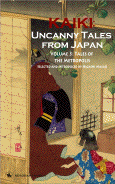Kaiki: Uncanny Tales from Japan, Volume 3: Tales of the Metropolis
Kaiki: Uncanny Tales from Japan
Volume 3 – Tales of the Metropolis 【都会の物語】
Selected and with commentary by
HIGASHI Masao
Preface by Robert WEINBERG
The third and final volume of our Kaiki series returns us to the Capital City: Tokyo. While Japan has modernized, renaming old Edo as new-born Tokyo, strange secrets remain hidden under the chrome and spotlights, unaffected by our beliefs in Science and Technology. Enjoy a new collection of stories introducing the strange denizens and happenings of the shadowy world of Japanese uncanny literature. Selected and with commentary by Higashi Masao, a recognized researcher and author in the field.
Nominated for the 2012 Science Fiction and Fantasy Translation Awards!
Contents
Robert Weinberg
Preface
Higashi Masao
Introduction: "Earthquakes, Lightning, Fire, and Father"
translated by Miri Nakamura
Akutagawa Ryūnosuke 芥川龍之介
"A Bizarre Reunion" (奇怪な再会; 1921)
translated by Steven P. Venti
Murayama Kaita 村山槐多
"The Diabolical Tongue" (悪魔の舌; 1915)
translated by Jeffrey Angles
Tanizaki Jun’ichirō 谷崎潤一郎
"The Face" (人面疽; 1918)
translated by Kathleen Taji
Toyoshima Yoshio 豊島与志雄
"Ghosts of the Metropolis" (都会の幽気; 1924)
translated by Rodger Swan and Jeffrey Angles
Edogawa Rampo 江戸川乱歩
"Doctor Mera's Mysterious Crimes" (目羅博士の不思議な犯罪; 1932)
translated by Seth Jacobowitz
Minagawa Hiroko 皆川博子
"The Midsummer Emissary" (文月の使者; 1996)
translated by Ginny Tapley Takemori
Hisao Jūran 久生十蘭
"In Thy Shadow" (妖翳記; 1939)
translated by Derek Lin
Endō Shūsaku 遠藤周作
"Spider" (蜘蛛; 1959)
translated by Rossa O'Muireartaigh
Yamakawa Masao 山川方夫
"The Talisman" (お守り; 1960)
translated by Karen Sandness
Kawabata Yasunari 川端康成
"The Arm" (片腕; 1964)
translated by Mark Gibeau
Akae Baku 赤江瀑
"Expunged by Yakumo" (八雲が殺した; 1981)
translated by Nancy H. Ross
Morohoshi Daijirō 諸星大二郎
"A Sinister Spectre" (不安の立像; 1973)
translated by Mark MacWilliams; graphics by Dorothy Gambrell
Reviews
- ...a fascinating introduction to the uncanny literature of a nation and culture very different to our own and still comparatively unknown. I heartily recommend these books and look forward—with expectancy mixed with trepidation—to further encounters with more Kaiki.
John Howard, writing in Wormwood No. 20
Read the entire review - ...an outstanding set of publications. This is an invaluable contribution to scholarship on the supernatural in literature and folklore in Japan and elsewhere. The stories are accessible and entertaining; they could easily be used in an undergraduate class where they would illuminate some of the sources and motifs so prevalent in contemporary Japanese horror film, manga, and anime. Moreover, these stories provide an introduction not only to a variety of important authors—many of whom are underappreciated even in Japan—but also tempt the reader to venture more deeply into the cultural and folkloric contexts that inform them. In short, the series is a perfect entree into some of the enduring traditions of Japanese supernatural folklore and supernatural literature, and the cross fertilization between the two.
Michael Dylan Foster, Journal of Folklore Research - The stories themselves are a wonderful mixed bag. Some tales are very odd in structure, sometimes without a conventional ending and with a lesson to be learnt. [ ... ] But be warned Western horror fans unfamiliar with Asian horror, these are not ordinary horror tales, not all involve terror and violence, they differ greatly from a collection of western tales of the same genre.
—Elizabeth Vinton, Dark Matter - Japan's history of weird and uncanny tales (not to be confused with horror stories) is probably more rich and extensive than any country on earth. ...[These] writers knew what they were doing and were able to build on and refine Japan's storytelling traditions. Tales of the Metropolis collects tales from some of Japan's greatest writers, with stories ranging from 1915-1996. Names like Akutagawa Ryunosuke, Tanizaki Junichirō, Edogawa Rampo, and Kawabata Yasunari should be familiar to anyone with an interest in Japan. Some of the other authors may not be as well known, but they are carefully curated to deliver a slice of the best of Japanese weird fiction. [...] Anyone interested in weird fiction or Japanese literature is going to want the entire series on their shelf."
—Zack Davisson, Japan Reviewed
Details
- xvi + 302 pages
- Trade paperback 5" x 8" (127mm x 203mm)
- ISBN 978-4-902075-10-6
- Cover: "The Fox-Woman Kuzunoha Leaving Her Child" from the New Forms of Thirty-Six Ghosts series by Yoshitoshi Tsukioka
Higashi Masao (東 雅夫)
is a noted anthologist, literary critic, and the editor of Japan's first magazine specializing in kaidan (strange tales) fiction, named Yoo (幽).In 1982 he founded Japan's only magazine for research into strange and uncanny literature, Fantastic Literature Magazine (幻想文学, Gensō bungaku), published by Atelier Octa, serving as editor for twenty-one years until the magazine folded in 2003. It was an invaluable publication not only for its content, but also because it discovered and nurtured a host of new authors, researchers and critics in the field.
Recently he has concentrated on compiling anthologies, producing criticism of fantastic and horror literature, and researching the kaidan genre, active in a wide range of projects. As a critic he has suggested new styles and interpretations in the field, including the growing "Horror Japanesque" movement and the "palm-of-the-hand kaidan" consisting of uncanny stories told in no more than eight hundred characters. He is well-known as a researcher of the uniquely Japanese hyaku monogatari tradition, with numerous books and anthologies published.
He serves on the selections committees for various literary prizes in the kaidan genre, and since 2004 has written the Genyō (幻妖) book blog on uncanny and fantastic literature cooperatively with online bookseller bk1.
Robert Weinberg, author and editor,
is the author of sixteen novels, two short story collections, and sixteen non-fiction books. He has also edited over 150 anthologies. He is best known for his trilogy, the Masquerade of the Red Death, and his non-fiction book, Horror of the Twentieth Century. Bob is a two-time winner of the Bram Stoker Award; a two-time winner of the World Fantasy Award; and a winner of the Lifetime Achievement Award from the Horror Writers Association.His website is http://www.robertweinberg.net/


